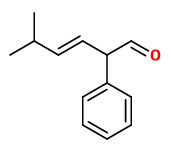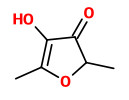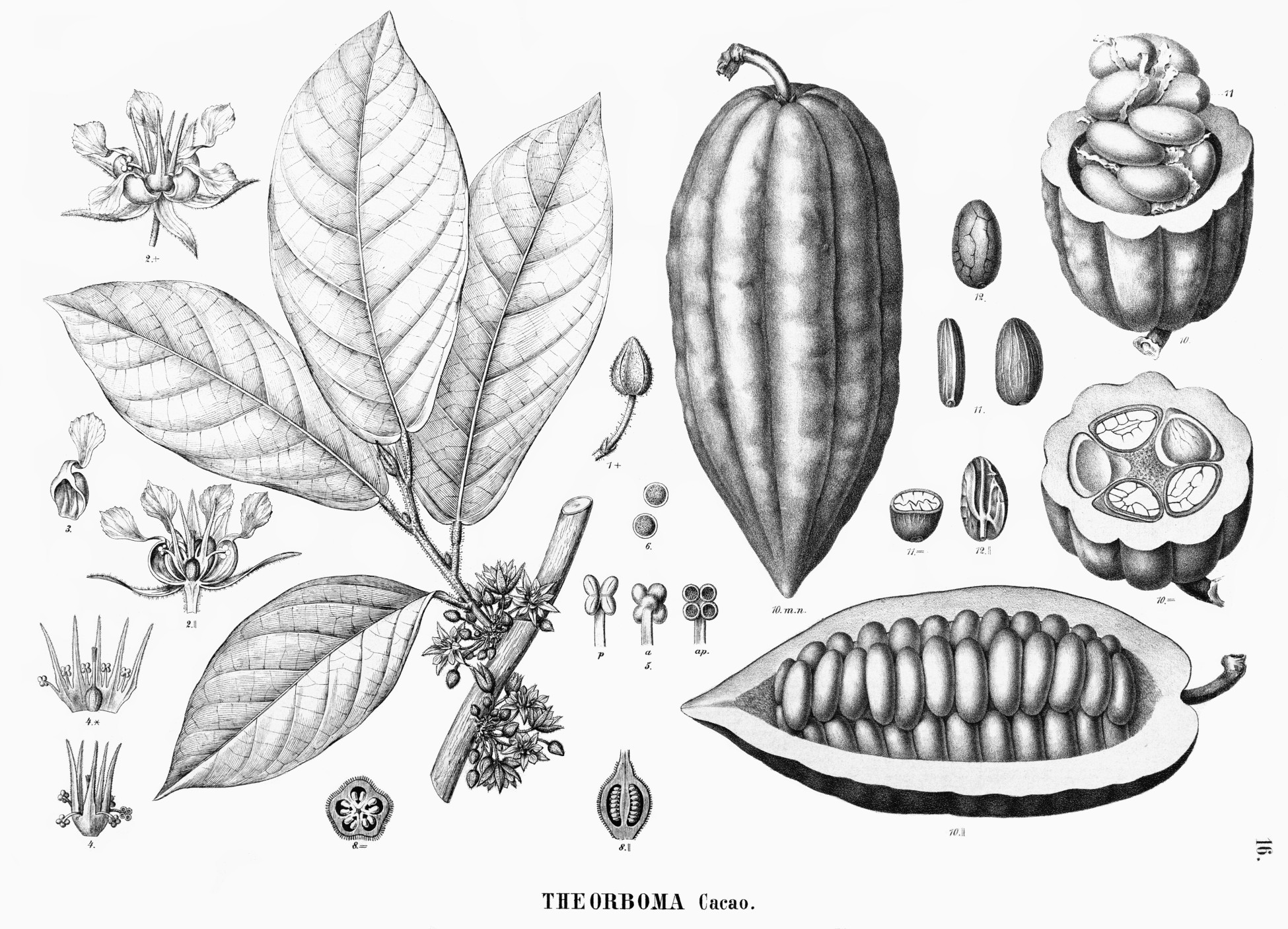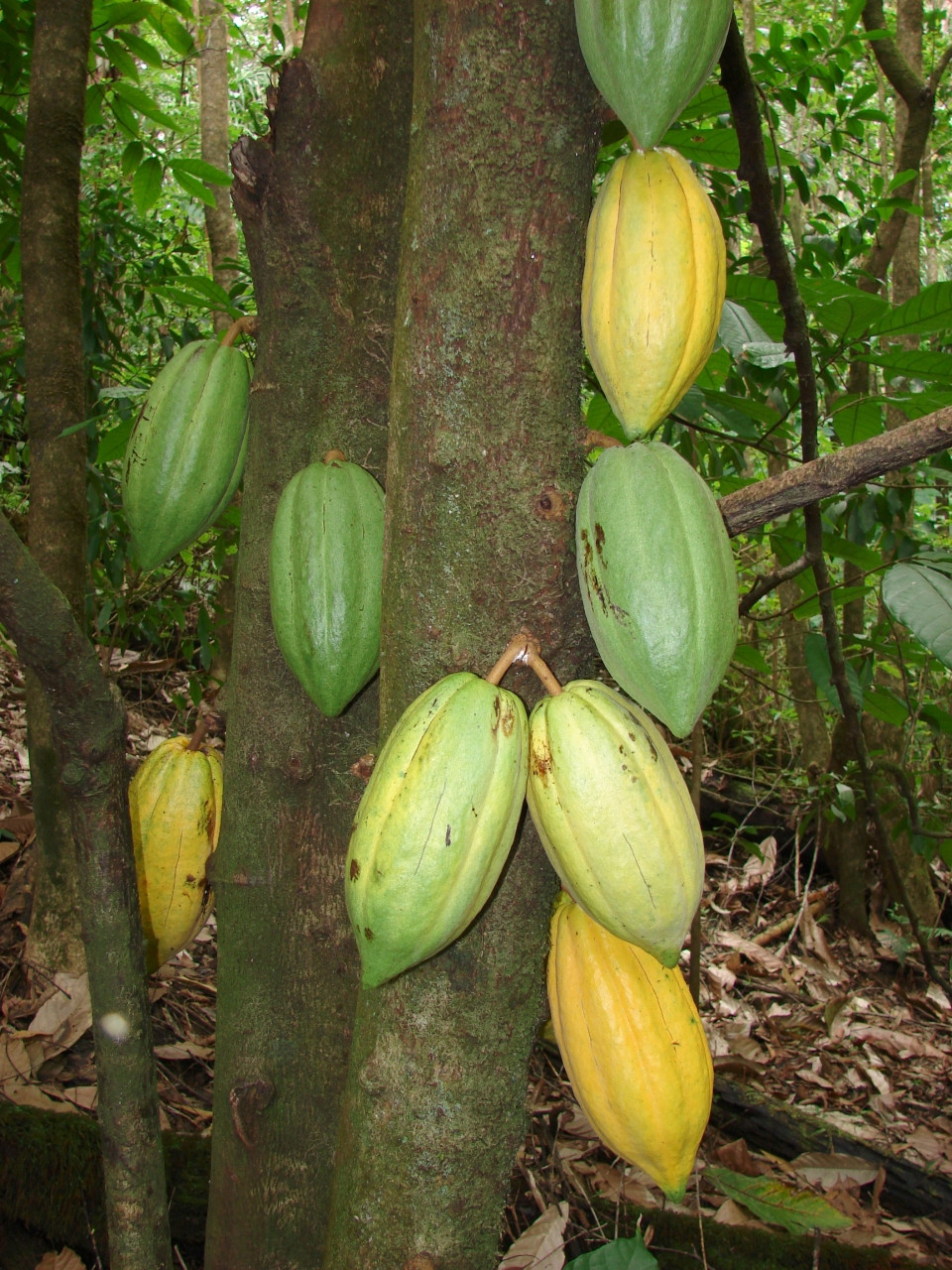Theobroma cacao L. - Malvaceae - cacao tree, cocoa tree, Kakaobaum
Evergreen tree, up to 10m high (3-4m in culture), native to Central and South America; leaves simple, shiny dark green, leathery, up to 50cm long; flowers small, white or red, cauline; fruit a ridged green, yellow or purple berry, 10-20cm long and 5-10cm broad; fruit with many bean-shaped seeds, covered by a mucilaginous pulp.
Of the identified steam-volatile components from cocoa beans, acetaldehyde, isobutyraldehyde, isovaleraldehyde, benzaldehyde, phenylacetaldehyde, 5-methyl-2-phenyl-2-hexenal (cocoa hexenal), 2-furaldehyde, dimethyl disulfide, acetic acid, isopentyl acetate, and alkyl-substituted pyrazines were found to contribute to cocoa aroma.
[Van Praag, Michel, Herbert S. Stein, and Merrick S. Tibbetts. „Steam volatile aroma constituents of roasted cocoa beans.“ Journal of agricultural and food chemistry 16.6 (1968): 1005-1008]
„The processing of cocoa seeds (Theobroma cacao, L.) comprises their drying, fermentation of sugars contained in the pulp covering the seeds, roasting, separation and grounding of the roasted nibs. The resulting fatty solid product (known as cocoa liquor) is the base raw material for chocolate industry. The most significant flavor-impact substances on cocoa derivatives are N- and O-containing heterocyclic compounds generated during the roasting, which are products of the complex sequence of heat-induced chemical processes collectively known as Maillard reactions. The substrates for the Maillard reactions are reducing sugars, small peptides, aminoacids and / or triglycerides contained in the raw, unroasted material. For cocoa, in terms of contribution to their sensorial characteristics (and, in consequence, to their commercial value), the most important Maillard reaction products are the alkylpyrazines. Considering their impact on the aroma, the ratios between the amounts of some alkylpyrazines [2,3-dimethylpyrazine, 2,6-dimethylpyrazine, trimethylpyrazine and tetramethylpyrazine] on the volatile fraction of of cocoa and chocolate (the pyrazinic ratios) can be adopted as parameter for quality assessment of these products.“
[A Headspace Solid Phase Microextraction (HS-SPME) method for the chromatographic determination of alkylpyrazines in cocoa samples. Pini, G. F., Brito, E. S. D., García, N. H., Valente, A. L., Augusto, F., Journal of the Brazilian Chemical Society, Vol.15(2), 2004, 267-271] http://www.scielo.br/scielo.php?pid=S0103-50532004000200017&script=sci_arttext
„Most of the volatile compounds identified are highly significant in determining cocoa powder flavour, and this paper demonstrates that basic sensory perceptions (undesirable, bitter pungent, repulsive, fruity, nutty, floral, vegetal, and sweet chocolate) can be totally explained by aroma compounds with R2-adjusted values of 0.85 and greater. Samples from five geographical origins of cocoa bean were characterized by chemical compounds and sensory attributes…. The major components of cocoa aroma were 2,3,5,6-tetramethylpyrazine, benzaldehyde, 2-phenylacetaldehyde, acetophenone, 3-methylbutyric acid, 5-methyl-2-phenyl-2-hexenal, ethyl phenylacetate, and 3-hydroxy-2-methyl-4-pyrone (mean greater than 1.30 mg kg−1).“
[Bonvehí, J. Serra. „Investigation of aromatic compounds in roasted cocoa powder.“ European Food Research and Technology 221.1-2 (2005): 19-29]
 5-methyl-2-phenyl-2-hexenal (cocoa hexenal, (E) shown) |  4-hydroxy-2,5-dimethyl-3(2H)-furanone (DHF, HDMF, furaneol) |  phenylacetaldehyde |  2-ethyl-3,5-dimethylpyrazine (3,5-cocoa pyrazine) |
„Isolation of the volatile fraction from cocoa powder (50 g; 20% fat content) by a careful extraction/distillation process followed by application of an aroma extract dilution analysis revealed 35 odor-active constituents in the flavor dilution (FD) factor range of 8-4096. Among them, 4-hydroxy-2,5-dimethyl-3(2H)-furanone (caramel-like), 2- and 3-methylbutanoic acid (sweaty, rancid), dimethyl trisulfide (cooked cabbage), 2-ethyl-3,5-dimethylpyrazine (potato-chip-like), and phenylacetaldehyde (honey-like) showed the highest FD factors. Quantitation of 31 key odorants by means of stable isotope dilution assays, followed by a calculation of their odor activity values (OAVs) (ratio of concentration to odor threshold) revealed OAVs > 100 for the five odorants acetic acid (sour), 3-methylbutanal (malty), 3-methylbutanoic acid, phenylacetaldehyde, and 2-methylbutanal (malty). In addition, another 19 aroma compounds showed OAVs > 1. To establish their contribution to the overall aroma of the cocoa powder, these 24 compounds were added to a reconstructed cocoa matrix in exactly the same concentrations as they occurred in the cocoa powder. The matrix was prepared from deodorized cocoa powder, which was adjusted to 20% fat content using deodorized cocoa butter. The overall sensory evaluation of this aroma recombinate versus the cocoa powder clearly indicated that the 24 compounds represented the typical sweet, cocoa-like odor of the real sample.“
[Identification of the key aroma compounds in cocoa powder based on molecular sensory correlations., Frauendorfer, Felix, Schieberle, Peter, Journal of agricultural and food chemistry, Vol.54(15) 2006, 5521-5529] http://worldcocoafoundation.org/wp-content/files_mf/frauendorfer2006.pdf
Character impact compounds of the volatile fraction of three commercial cocoa powders (Bensdorp, Krüger, Sarotti) isolated using thin-layer high-vacuum distillation (TLHVD) of Soxhlet extracts were: Acetic acid (vinegar), propanoic acid (mouldy), 2-methyl propanoic acid (rancid), phenylacetaldehyde (flowery), 2/3-methyl butanoic acid (sweaty), dehydromevalonic acid lactone (condesed milk, sour), 2-pyrrolidinone (popcorn), pyrrole-2-carboxaldehyde (nut), (R)-(−)-pantolactone (caramel, coconut), furaneol (caramel), massoia lactone (coconut), dihydroxymaltol (caramel), 4-methyl-5-(2-hydroxyethyl)thiazol (peanut), two solerol isomers (red fruit, jam, green notes), vanillin (vanilla) and phenylacetic acid (sweet, flowery). These 17 compounds were detected at the sniff port of the GC-O after a 1:100 dilution. The aroma extract contained acetoin and several alkylated pyrazines e.g.
[Krings, Ulrich, et al. „Thin-layer high-vacuum distillation to isolate volatile flavour compounds of cocoa powder.“ European Food Research and Technology 223.5 (2006): 675-681]
„Cocoa beans (Theobroma cacao) are the major raw material for chocolate production and fermentation of the beans is essential for the development of chocolate flavor precursors. In this study, a novel approach was used to determine the role of yeasts in cocoa fermentation and their contribution to chocolate quality… Quality tests revealed that beans fermented without yeasts were purplish-violet in color and not fully brown, and chocolate prepared from these beans tasted more acid and lacked characteristic chocolate flavor. Beans fermented with yeast growth were fully brown in color and gave chocolate with typical characters which were clearly preferred by sensory panels. Our findings demonstrate that yeast growth and activity were essential for cocoa bean fermentation and the development of chocolate characteristics.“
[Yeasts are essential for cocoa bean fermentation. Van Thi Thuy Ho, Jian Zhao, Graham Fleet, International Journal of Food Microbiology, Vol.174, 2014, 72-87]
„In contrast to cocoa from Ecuador, the Chontalpa cocoa shows an intense and distinctive fingerprint of alkyl pyrazines (2,3,5-trimethyl, 2,6 -dimethyl, 2,3-dimethyl, 2-ethyl-3,5-dimethyl, 2-ethyl-5(6)-methyl, and 3,5-diethyl-2-methyl pyrazine) and linear esters (e.g., ethyl pentanoate, ethyl hexanoate, ethyl octanoate, and ethyl decanoate). In addition, Chontalpa is characterized by a distinctive signature of some key aroma compounds, including acetic acid (sour), phenyl acetaldehyde (honey-like), 2-phenyl ethanol (flowery), phenyl propanoid derivates (benzaldehyde and benzyl alcohol), 3-methyl butanal (malty), and butanoic acid (sweaty). On the other hand, the Ecuador aroma signature results from 2-heptanol (citrusy), 3-methyl butanoic acid(rancid), and dimethyl trisulfide (sulfurous).“
[Magagna, Federico, et al. „Advanced fingerprinting of high-quality cocoa: Challenges in transferring methods from thermal to differential-flow modulated comprehensive two dimensional gas chromatography.“ Journal of Chromatography A 1536 (2018): 122-136] https://aperto.unito.it/retrieve/handle/2318/1644892/351315/Manuscript%20OA_4aperto.pdf
Chocolate is a sweet food preparation of Theobroma cacao seeds.
„Application of an aroma extract dilution analysis (AEDA) on the volatiles of a commercial milk chocolate revealed 51 odor-active compounds in the flavor dilution (FD) factor range 8−1024, 44 of which could be identified. The following 13 odorants contributed with the highest FD factors to the overall chocolate flavor: 3-methylbutanal (malty); 2-ethyl-3,5-dimethylpyrazine (potato chip-like); 2- and 3-methylbutanoic acid (sweaty); 5-methyl-(E)-2-hepten-4-one (hazelnut-like); 1-octen-3-one (mushroom-like); 2-ethyl-3,6-dimethylpyrazine (nutty, earthy); 2,3-diethyl-5-methylpyrazine (potato chip-like); (Z)-2-nonenal (green, tallowy); (E,E)-2,4-decadienal (fatty, waxy); (E,E)-2,4-nonadienal (fatty); R-δ-decalactone (sweet, peach-like); and 2-methyl-3-(methyldithio)furan. Application of the AEDA on the cocoa mass used in the production of the milk chocolate led to the identification of 37 odorants, seven of which were sensorially not detected in the chocolate. By contrast, 11 odorants were present in the milk chocolate but were not sensorially relevant in cocoa mass, e.g., R-δ-decalactone and 5-methyl-(E)-2-hepten-4-one.“
[Schnermann, Petra, and Peter Schieberle. „Evaluation of key odorants in milk chocolate and cocoa mass by aroma extract dilution analyses.“ Journal of Agricultural and Food Chemistry 45.3 (1997): 867-872]
„By application of the aroma extract dilution analysis on a flavor distillate obtained by high vacuum distillation of bitter chocolate 33 odor-active compounds were sensorially detected. Among the 29 odorants identified, vanillin, 2-methoxy-3-isopropylpyrazine, 2,3-diethyl-5-methylpyrazine followed by 2- and 3-methylbutanoic acid, 2-phenylethanol and 4-hydroxy-2,5-dimethyl-3(2H)-furanone showed the highest FD-factors. Compared to a milk chocolate, especially the FD-factors of the latter compound and the methoxypyrazine were much higher. In an extract obtained by simultaneous steam distillation/extraction of a milk chocolate, the concentration of, particularly, phenylacetaldehyde was increased by a factor of 120 compared to that in an extract obtained by the more careful high vacuum distillation. In addition, also 5-methyl-(E)-2-heptene-4-one, diacetyl and 3-methylbutanal were much higher in the SDE.“
[Characterization of key odorants in chocolate., Schieberle, Peter, Pfnuer, Petra, Flavor chemistry. Springer US, 1999, 147-153]
„After vacuum distillation and liquid−liquid extraction, the volatile fractions of dark chocolates were analyzed by gas chromatography- olfactometry and gas chromatography- mass spectrometry. Aroma extract dilution analysis revealed the presence of 33 potent odorants in the neutral/basic fraction. Three of these had a strong chocolate flavor: 2-methylpropanal, 2-methylbutanal, and 3-methylbutanal. Many others were characterized by cocoa/praline-flavored/nutty/coffee notes: 2,3-dimethylpyrazine, trimethylpyrazine, tetramethylpyrazine, 3(or 2),5-dimethyl-2(or 3)-ethylpyrazine, 3,5(or 6)-diethyl-2-methylpyrazine, and furfurylpyrrole. Comparisons carried out before and after conching indicate that although no new key odorant is synthesized during the heating process, levels of 2-phenyl-5-methyl-2-hexenal, furaneol, and branched pyrazines are significantly increased while most Strecker aldehydes are lost by evaporation.“
[Use of gas chromatography-olfactometry to identify key odorant compounds in dark chocolate. Counet, C., Callemien, D., Ouwerx, C., Collin, S., Comparison of samples before and after conching., Journal of agricultural and food chemistry, Vol.50(8), 2002, 2385-2391]
„A number of compounds have been identified by gas chromatography-olfactometry (GC-O) as key odorant compounds in dark chocolate. 2-Methylpropanal, 3-methylpropanal and 2-methylbutanal have been related to chocolate odors while trimethylpyrazine, 2,5-dimethylpyrazine and acetylpyrrole have been attributed cocoa odors. Methylpyrazine, 2,3-dimethylpyrazine, 2-ethyl-6-methylpyrazine and benzaldehyde added a hazelnut/almond note to the aroma profile of chocolate; ethylpyrazine, 3-ethyl-2,5-dimethylpyrazine and tetramethylpyrazine a roasty note.“
[Evaluation of solid-phase micro-extraction coupled to gas chromatography-mass spectrometry for the headspace analysis of volatile compounds in cocoa products. Ducki, S., Miralles-Garcia, J., Zumbé, A., Tornero, A., Storey, D. M., Talanta, Vol.74(5), 2008, 1166-1174]
„The specific cocoa aroma arises from complex biochemical and chemical reactions during the postharvest processing of raw beans, and from many influences of the cocoa genotype, chemical make‐up of raw seeds, environmental conditions, farming practices, processing, and manufacturing stages. There has been much research on cocoa flavor components. However, the relationships between all chemical components that are likely to play a role in cocoa flavor, their sensory properties, and the sources and mechanisms of flavor formation are not fully understood.“
[Aprotosoaie, Ana Clara, Simon Vlad Luca, and Anca Miron. „Flavor chemistry of cocoa and cocoa products—an overview.“ Comprehensive Reviews in Food Science and Food Safety 15.1 (2016): 73-91] https://onlinelibrary.wiley.com/doi/full/10.1111/1541-4337.12180

Theobroma cacao L.; Martius, C., Eichler, A.G., Urban, I., Flora Brasiliensis, vol.12(3) f.96 t.16 (1886)
http://botanicalillustrations.org/species.php?id_species=1011749

Theobroma cacao fruits ripening along the trunk
CC BY-SA 3.0, Author: Forest and Kim Starr Useful Tropical Plants
